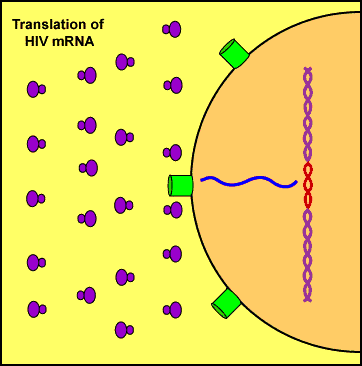
Once synthesized, HIV mRNA goes through the nuclear pores into the rough endoplasmic reticulum to the host cell's ribosomes where it is translated into HIV structural proteins, enzymes, glycoproteins, and regulatory proteins.
A 9 kilobase mRNA is formed that is used for three viral functions:
a. Synthesis of Gag polyproteins (p55). These polyproteins will eventually be cleaved by HIV proteases to become HIV matrix proteins (MA; p17), capsid proteins (CA; p24), and nucleocapsid proteins (NC, p7).
b. Synthesis of Gag-Pol polyproteins (p160). These polyproteins will eventually be cleaved by HIV proteases to become HIV matrix proteins (MA; p17), capsid proteins (CA; p24), proteinase molecules (protease or PR; p10), reverse transcriptase molecules (RT; p66/p51), and integrase molecules (IN; p32).
c. During maturation, these RNA molecules also become the genomes of new HIV virions.
The 9kb mRNA can also be spliced to form a 4kb mRNA and a 2kb mRNA.
The 4kb mRNA is used to:
a. Synthesize the Env polyproteins (gp160). These polyproteins will eventually be cleaved by proteases to become HIV envelope glycoproteins gp120 and gp41.
b. Synthesize 3 regulatory proteins called vif, vpr, and vpu (not shown here).
The 2kb mRNA is used to synthesize 3 regulatory proteins known as tat, rev, and naf (not shown here).
GIF Animation of translation of HIV mRNA into polyproteins by Gary E. Kaiser, Ph.D.
Professor of Microbiology,
The Community College of Baltimore County, Catonsville Campus
This work is licensed under a Creative Commons Attribution 4.0 International License.
Based on a work at https://cwoer.ccbcmd.edu/science/microbiology/index_gos.html.
Last updated: Feb., 2018
Please send comments and inquiries to Dr.
Gary Kaiser